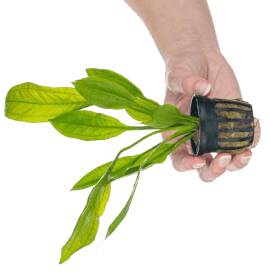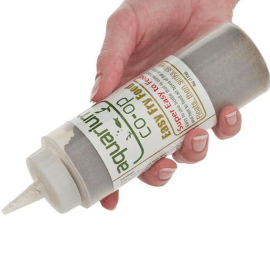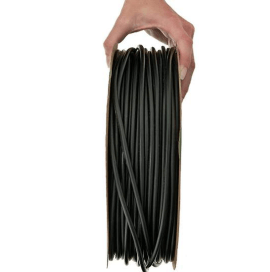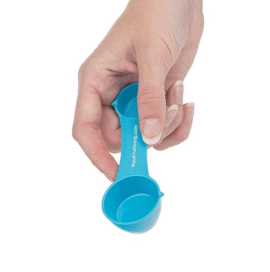Care Guide for Ember Tetras — Orange Jewels of the Nano Aquarium
A staple of the freshwater nano aquarium world is the ember tetra. Just imagine a school of tiny, flame-colored fish darting back and forth amongst a lush forest of green aquarium plants. Plus, its peaceful nature and hardiness makes it an attractive choice for both beginners and veterans in the fishkeeping hobby. If you’ve never tried keeping ember tetras before, then keep reading to find out why they’re such a top-selling species at our fish store.
What are Ember Tetras?
Hyphessobrycon amandae is a common tetra found in Brazil, and it comes from the same genus as many other well-known tetras in the pet trade — such as the black neon tetra, Von Rio tetra, and lemon tetra. This species only grows up to 0.8 inch (2 cm), but it packs a powerful punch with its bright, red-orange body that is slightly translucent with a coppery sheen. Unlike many other nano fish, ember tetras are relatively outgoing, especially in large groups, and won’t dart away as soon as you approach their tank.

Hyphessobrycon amandae
How to Set Up an Aquarium for Ember Tetras
Because of their little size, you have the flexibility to keep them in a 5-gallon nano tank with a smaller school or a larger tank with a massive group. They come from mildly acidic waters but are adaptable enough to handle pH of 5.5–7.5, 72–82°F (22–28°C), and very soft to moderately hard water. Slow flow with gentle filtration using a sponge filter or pre-filter sponge is preferred. We find that ember tetras tend to show brighter colors in planted tanks with a dark substrate and background. To create more of a South American biotope look, some hobbyists also like to add catappa leaves, driftwood, and other interesting botanicals.
How many ember tetras should I keep together? As with most tetras, they are naturally social creatures that feel the most comfortable when surrounded by their own kind. They do not tightly school together but hang out mostly in a loose group or shoal. With such a diminutive size, we like to get at least 6–10 of them so they make more of an impact in the aquarium.
What fish can live with ember tetras? They are the perfect community fish and do fine with any similar-sized, peaceful animals that won’t eat them. For example, you can keep them with other nano schooling fish such as rasboras, tetras, and danios. Since they tend to swim around the middle of the aquarium, we like to pair them with bottom-dwelling corydoras catfish and surface-dwelling hatchetfish or pencilfish. Plus, their gregarious nature makes them well-suited as dither fish for Apistogramma dwarf cichlids or other timid creatures. We also find they get along with algae eaters like otocinclus catfish and dwarf shrimp. While they will leave the adult shrimp alone, almost all fish will opportunistically go after baby shrimp, so provide plenty of dense plants and caves for them to hide.
Can I put a betta fish with ember tetras? A blue betta fish or powder blue dwarf gourami would look amazing as a centerpiece fish among a sea of ember tetras because blue and orange are complementary colors. However, some bettas or dwarf gouramis can be quite territorial, so be prepared to move them if too much aggression ensues.

Ember tetras in a community tank
What do Ember Tetras Eat?
In nature, they are omnivores that enjoy eating zooplankton, small invertebrates, and plant matter. While ember tetras are not picky eaters, they do have little mouths that prefer to feed on tiny, slow-sinking foods. Plus, feeding a varied diet of different fish foods will help them get plenty of essential nutrients and vitamins to live a long and healthy life. Our favorite foods include:
- Nano pellets
- Crushed flakes
- Baby brine shrimp
- Easy Fry and Small Fish Food
- Daphnia
- Cyclops
- Rotifers
How to Breed Ember Tetras
It can be hard to sex ember tetras, so we recommend buying at least six fish to have a higher chance of getting both males and females. Males are slender in profile, while females have rounder bodies, especially when viewed from above. As egg scatterers, they display no parental care and will happily predate on their own eggs and newborn fry. That being said, ember tetras can be bred in a colony setting where the parents are kept with the young. The key is to put them in a seasoned, matured aquarium with lots of natural microfauna for the fry to feed on and dense plants (like Pogostemon stellatus ‘octopus’ and water sprite) for the fry to hide amongst.

A school of ember tetras in a densely planted tank
To produce greater numbers, prepare a small, mature tank with a sponge filter or air stone for slow flow. Cover the entire bottom of the tank with plastic craft mesh, and underneath it, place a bed of java moss (or DIY spawning mop) as shelter. The barrier allows the eggs to fall through the holes, while blocking the adults from reaching them. You can also add some catappa leaves on the ground to create biofilm for the fry to eat and slightly acidify the water if you have higher pH. After heavily feeding the adults and conditioning them to spawn, transfer them to the breeding aquarium. Remove the adults after a few days of spawning, especially if you spot any fry.
The tiny babies require miniscule foods such as infusoria, vinegar eels, and powdered fry food at first. Feed them small meals multiple times a day, and keep the water quality clean and stable by doing small water changes every day. Depending on the water temperature and size of the fry, they may be able to start eating baby brine shrimp after a couple of weeks, which will greatly increase their growth and survival rates. If you see a great disparity in the sizes of the baby fish, you may need to move the bigger fry to another grow-out tank so the smaller fry won’t get outcompeted for food.
While Aquarium Co-Op does not ship live fish, we have a list of preferred online vendors for you to browse that can ship aquarium animals right to your door. And for further inspiration, read our article about the top 5 nano fish that can live in a 5-gallon aquarium on your office or room desk.




